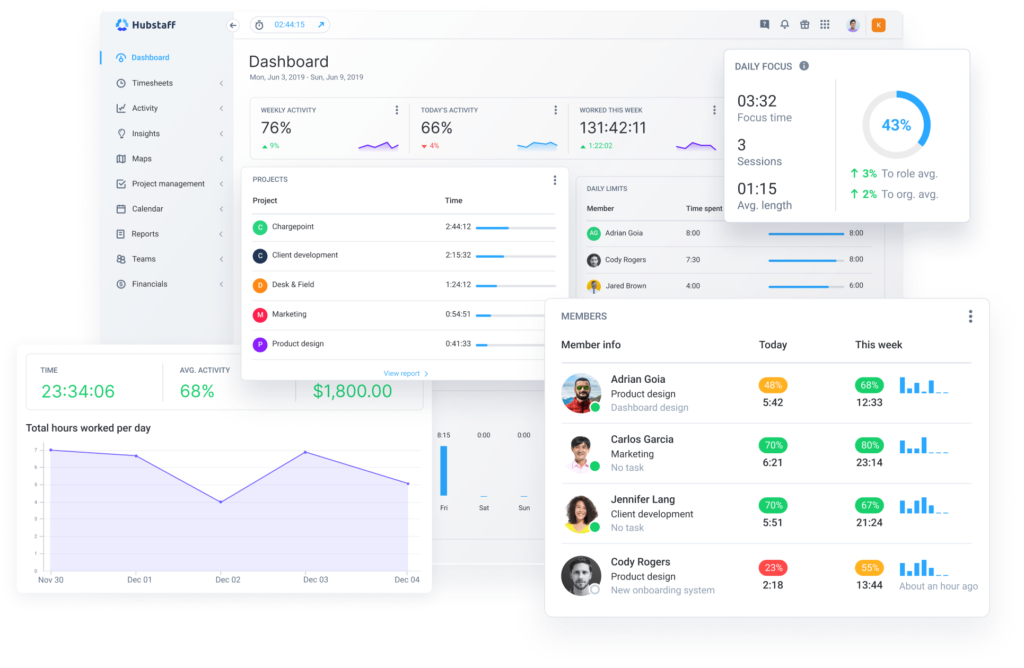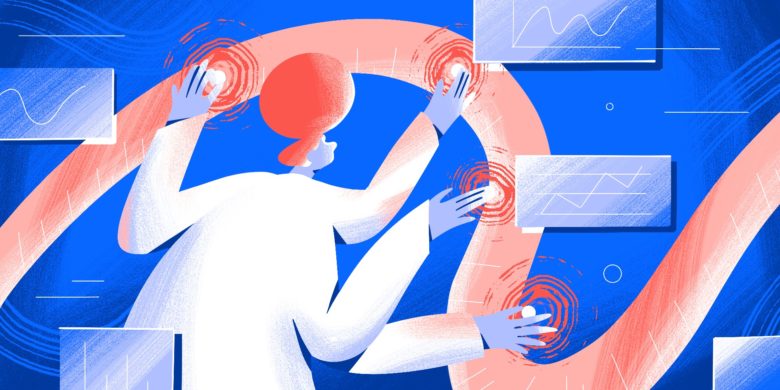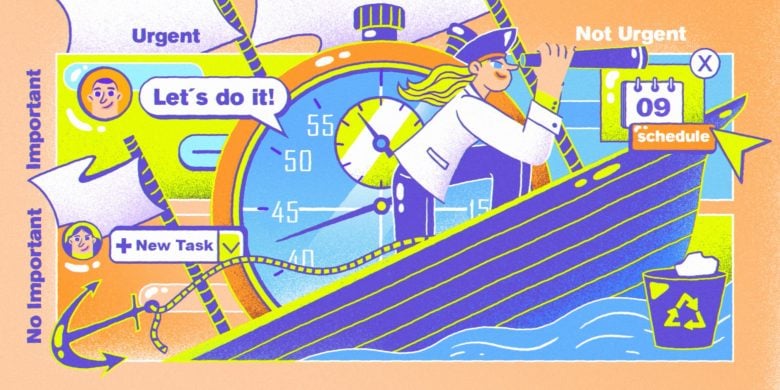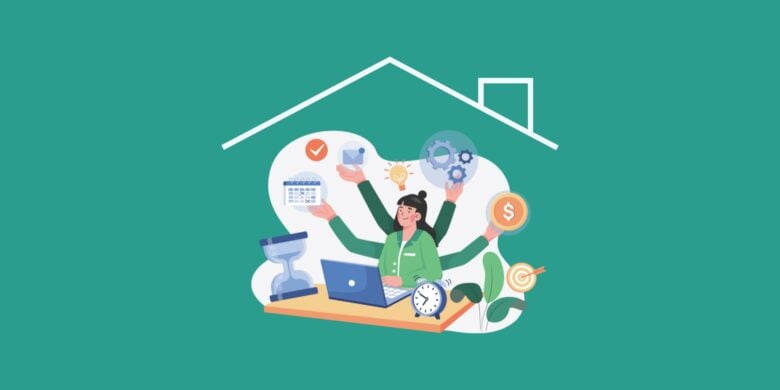As someone who has spent years studying the intricacies of productivity, I’ve discovered that learning to be more productive is more than just checking items off a to-do list for eight hours.
Productivity is all about creating a harmonious balance between work and personal time and learning how to prioritize tasks. Today, I’ll share insights and methods to help you boost your productivity across different areas of your life.
Whether you’re juggling remote work demands, trying to keep your home life organized, or looking to tackle personal projects more effectively, these strategies can help. Let’s dive in.
Boost your team’s efficiency with Hubstaff's productivity tools
Why productivity matters
I could talk about productivity all day. And often, I do. But, for your sake, my gentle reader, I’m going to wrap up the importance of productivity in a concise list of data-based information:
- Actively disengaged employees cost the U.S. $483 to $605 billion annually in lost productivity.
- Productivity stats on top-performing employees go up as high as 800% because they are highly efficient and deliver quality in complex jobs.

It’s nearly impossible to overstate the importance of productivity. Now that you’re (hopefully) on board with me, let’s get into some meaningful strategies. I promise not to tell you things like “make a to-do list.” I’ve found that meaningful techniques and methods are better than cheap, quick advice.
How to be more productive at work
I’m a productivity nerd, so the last thing I will do is list one million productivity tips and strategies for you to become more productive at work. I’ve found that becoming more productive comes down to three simple steps.
1. Eliminate distractions
Before you can start being productive, you must eliminate the things holding you back.
- Turn off notifications. While you’re drinking your morning coffee, disable non-essential notifications on your phone and computer. If you’re anything like me, constant pings from social media, emails, and apps can break your focus and disrupt your workflow. I turn my phone on Do Not Disturb mode during work hours and find it helps eliminate distractions.
- Set clear boundaries. Communicate your work hours to family, friends, and colleagues. Let them know when you’re available and when you need uninterrupted time to focus on your most important tasks.
- Work remotely when possible. Hubstaff data determined that remote employees spend more time daily on focused tasks, which means fewer distractions and increased productivity.

By implementing these strategies, you can create an environment that minimizes distractions and maximizes your productivity. It’s time to get your goals in order once distraction-free (or as close as possible).
2. Set clear goals and deadlines
Setting clear goals and deadlines is crucial for boosting productivity and completing tasks efficiently. I can attest that a structured approach to goal-setting can help you stay focused and motivated.
Here are some effective goal-setting strategies of productive people that are worth considering:
- SMART goals: Create Specific, Measurable, Achievable, Relevant, and Time-bound goals. This framework ensures that your goals are clear and attainable within a specified timeframe, making tracking progress and staying motivated easier.
- Key Performance Indicators (KPIs): Use KPIs to measure the success of your goals. KPIs are specific metrics that provide insight into how well you’re achieving your objectives. They help quantify progress and identify areas that need improvement.
- OKRs (Objectives and Key Results): Adopt the OKR methodology to set ambitious goals with measurable outcomes. This approach involves defining high-level objectives and outlining the key results needed to achieve them. The goal of OKRs is to help foster alignment and engagement across teams.
Regular reviews and visualization techniques further ensure you stay motivated and on track. Effective goal-setting is about what you aim to achieve and how you plan and measure your progress.
3. Use productivity hacks to manage tasks
I’ve researched and written about over a dozen different productivity techniques, which are the key to keeping your productivity levels high. But it’s not a one-size-fits-all situation.
Here are my favorite productivity hacks. Try them out and see which one works best for you.
- Biological Prime Time. Biological Prime Time involves identifying the times of day when you are naturally most alert and energetic and scheduling your most important and demanding tasks during these peak periods to maximize efficiency and performance.
- ZTD (Zen to Done). ZTD is a time management system that focuses on simplicity and stress reduction by incorporating healthy habits such as collecting tasks in one place, processing them regularly, and doing one task at a time until you’ve completed everything on your to-do lists. ZTD is inspired by the Getting Things Done (GTD) methodology.
- 2-Minute Rule. The 2-Minute Rule is a simple yet effective productivity hack that suggests if smaller tasks can be completed in two minutes or less, you should do it immediately rather than putting it off for later.
- Swiss Cheese Method. The Swiss cheese method involves breaking down large, daunting tasks into smaller, manageable chunks. From there, the idea is to put “holes” in the task until it is completely finished. This helps you make steady progress without feeling overwhelmed.
- Day Theming. Day Theming is a time management technique where you assign specific themes or types of work to each day of the week. This allows you to focus on similar tasks together and maintain a consistent workflow to reach peak productivity. It can also help reduce the time you waste rapidly switching between different activities.
Finally, at Hubstaff, we’re all about using digital tools to increase productivity and automate work. Our favorite tool is our own, of course.
Bonus tip: Use Hubstaff to increase productivity
Using Hubstaff to boost productivity at work is a game-changer. It provides real-time tracking of tasks and time spent, helping you understand where your efforts are going. With features like activity monitoring, automated timesheets, and detailed productivity reports, you can quickly identify areas for improvement and streamline your workflow.

Hubstaff also integrates with your favorite project management tools, which makes project management seamless. Whether you’re managing a remote team or working solo, Hubstaff ensures that you use every minute of your time effectively and helps you stay focused and productive.
How to be more productive at home
While my productivity expertise and research mainly focus on the workplace, I’m a firm believer in using productivity methods to keep my personal life in line as well. For me, productivity at home falls into a few main categories: using a planner, establishing a morning routine, and managing personal tasks efficiently.
Use a digital planner
I was obsessed with my physical planner for years and loved keeping notes with pen and paper. Recently, I’ve become a digital calendar convert. Rest assured, I thought long and hard about where I would keep my digital calendar. Here were my top choices:
- Google Calendar. Google Calendar is great for keeping your schedule organized across devices. I love how easy it is to create events, set reminders, and share calendars with others. The color-coding feature helps me visually separate work from personal tasks and integrates perfectly with my other Google apps, like Gmail.
- Trello. Trello is my go-to for organizing tasks visually. I love how I can create boards for different projects, and the drag-and-drop feature makes it easy to move tasks around. It’s great for both personal planning and team collaboration.
- Apple Calendar. When I’m on my Mac or iPhone, I use Apple Calendar because it syncs across all my Apple devices instantly. The interface is simple, and I appreciate the ability to create multiple calendars for different aspects of my life. Inviting others to events and getting notifications straight to my Apple Watch is also easy.
I opted to use Apple Calendar, but I think any of these tools would work great.
Establish a routine
You know that feeling when your day just flows? That’s the magic of a good routine. A consistent daily schedule is like giving your brain a roadmap for the day. Establishing a routine reduces decision fatigue because you’re not constantly figuring out what to do next. Instead, you move from task to task with more intense focus and less stress.
One of the most significant benefits of sticking to a routine is that it helps build momentum. When you start your day the same way, your brain gets into work mode faster. The faster you can lock in, the easier it is to tackle those big tasks. Plus, a routine can help you save time for important things (like exercise, learning, or even relaxing) so you’re not scrambling to fit them in.
Consistency also brings a sense of control and balance to your life. When your day is predictable, you’re less likely to feel overwhelmed by the unexpected. It’s like setting yourself up for success every single day.
Manage household tasks efficiently
Let’s face it: keeping up with household tasks can feel like a never-ending chore. But with a little organization, you can turn chaos into calm. The key is to break tasks into manageable chunks and create a system that works for you.
Start by listing all the regular tasks that need to be done, from laundry and dishes to grocery shopping and cleaning. Once everything is laid out, try assigning specific tasks to certain days or times. For example, maybe Monday is laundry day, while Wednesday is for tackling the bathrooms. By spreading things out, you avoid the stress of trying to do everything at once.
Common questions about productivity
Do you still have questions? Let’s do a speed round of some FAQs about productivity.
What is the best way to be productive?
The best way to be productive is to prioritize tasks based on their importance and urgency and focus on one task at a time until it’s completed. Techniques such as time blocking and the Pomodoro Technique can help maintain focus and manage time effectively, while tools like task management apps can keep you organized and on track with your most challenging tasks.
How can I make myself productive every day?
To make yourself productive every day, establish a consistent routine that includes setting clear, achievable goals and starting with the most critical tasks during your peak energy hours. Incorporate regular breaks to recharge, minimize distractions by creating a focused work environment, and use productivity tools to stay organized and motivated.
How can I stay focused while working from home?
Set up a dedicated workspace, maintain a regular schedule, and minimize distractions by turning off notifications for a few hours and communicating boundaries with household members.
How can technology help improve productivity?
Technology can enhance productivity by automating repetitive tasks, organizing schedules, and providing tools for collaboration and communication, such as project management software and time tracking tools like Hubstaff.
How can I reduce procrastination?
To overcome initial resistance, break tasks into smaller, manageable steps, set clear goals and use techniques like the 2-Minute Rule (if it takes less than two minutes, do it now).
Final words on productivity
The key takeaway from these strategies is that mastering your own productivity isn’t just about knocking out your most important task or getting more done — it’s about creating a balanced and efficient approach to work, life, and your mental health. By eliminating distractions, setting clear goals, and using proven productivity hacks, you can optimize your time and energy levels, whether at work, at home, or managing personal projects.
Establishing routines and efficiently managing different tasks further enhances your ability to stay focused and maintain momentum. Ultimately, these methods help you work smarter, not harder, leading to greater success and a more harmonious life.
Most popular
The Critical Role of Employee Monitoring and Workplace Security
Why do we need employee monitoring and workplace security? Companies had to adapt fast when the world shifted to remote work...
15 Ways to Use AI in the Workforce
Whether through AI-powered project management, strategic planning, or simply automating simple admin work, we’ve seen a dramatic...
The AI Productivity Panel: Lessons From Leaders on What’s Working (and What’s Not)
When I moderated this AI productivity panel, I expected a solid conversation. What I didn’t expect was the flood of real-world i...
Employee Performance Dashboards: Templates, Tools, and Best Practices
Keeping track of how your team’s really doing can be tricky. Spreadsheets pile up, one-on-ones only tell part of the story, and...




